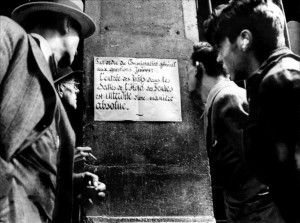The cinema has produced few more impressive pieces of investigative journalism than this epic 1971 documentary by Marcel Ophuls — 260 minutes long, plus a 15-minute intermission — about the German occupation of France. Ophuls, son of the great Max Ophuls, devotes the first part to the fall of France, the second part to everyday life during the Occupation up through the Liberation. In both parts he focuses on the city of Clermont-Ferrand, not far from Vichy, and the heart of the film consists of relaxed interviews with survivors — French as well as German, resistance fighters as well as collaborationists — and newsreels and propaganda films from the period. The interviews are dated somewhat by the dearth of female subjects (only one out of the 36 principal speakers, and a Petain supporter at that); women are often visible, but apart from the occasional interjection they function mainly as domestic decor. One of the film’s abiding strengths is Ophuls’s refusal to rely on easy ironies or facile divisions between heroes and villains, despite his implicit emphasis throughout on ethical issues. Near the beginning and end of the film he employs the unsettling technique of freezing the frame while the subject’s voice continues, which suggests that even the “frozen” past still has fresh things to tell us. Yet in spite of this trope and an overall feeling for novelistic detail, The Sorrow and the Pity isn’t an aesthetic statement in the same way or to the same degree as a subsequent masterpiece like Claude Lanzmann’s Shoah; it’s valuable mainly as a brilliant assemblage of documents and testimonies, one that permanently altered our understanding of World War II. A restored 35-millimeter print, “presented by Woody Allen,” will be shown. Gene Siskel Film Center, Art Institute, Columbus Drive at Jackson, Friday, July 14, 7:00, and Saturday and Sunday, July 15 and 16, 1:00, 312-443-3737.
–Jonathan Rosenbaum

